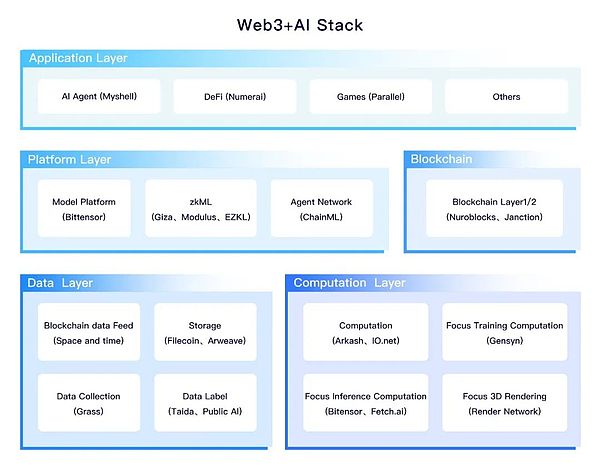
When Huang Renxun gave a speech at WGS in Dubai, he proposed the word “Social AI”.So, which sovereign AI can meet the interests and demands of the Crypto community?
Maybe it needs to be built in the form of Web3+AI.
In the article “The promises and challenges of crypto + AI applications”, Vitalik talks about the synergy between AI and Crypto: the decentralization of Crypto can balance the centralization of AI; AI is opaque, and Crypto brings transparency; AI requires data,Blockchain is conducive to data storage and tracking.This collaboration runs through the entire industry landscape of Web3+AI.
Most Web3 + AI projects are using blockchain technology to solve the construction problems of infrastructure projects in the AI industry, and a few projects use AI to solve certain problems in Web3 applications.
The Web3 + AI industry landscape is roughly as follows:

The production and workflow of AI are roughly as follows:

In these links, the combination of Web3 and AI is mainly reflected in four aspects:
1. Computing power layer: Computing power assetization
In the past two years, the computing power used to train AI models has increased exponentially, basically doubling every quarter, growing wildly at a rate far exceeding Moore’s Law.This situation has led to a long-term imbalance in the supply and demand of AI computing power, and the prices of hardware such as GPUs have risen rapidly, which has in turn increased the cost of computing power.
But at the same time, there are also a large number of mid- and low-end computing power hardware in the market, and the single computing power of this part of mid- and low-end hardware may not meet the high-performance needs.However, if a distributed computing power network is built through Web3, and a decentralized computing resource network can be built through computing power leasing and sharing, it can still meet many AI application needs.Since it uses distributed idle computing power, the cost of AI computing power can be significantly reduced.
The computing power layer segmentation includes:
-
General decentralized computing power (such as Arkash, Io.net, etc.);
-
Decentralized computing power used for AI training (such as Gensyn, Flock.io, etc.);
-
Decentralized computing power used for AI inference (such as Fetch.ai, Hyperbolic, etc.);
-
Decentralized computing power for 3D rendering (such as The Render Network, etc.).
The core advantage of Web3+AI’s computing power asset is decentralized computing power projects. It is easy to expand the network scale with token incentives. Moreover, its computing resources are low and cost-effective, which can meet some mid- and low-end computing power.need.
2. Data layer: data assetization
Data is the oil and blood of AI.If you do not rely on Web3, generally only giant companies have a large amount of user data. It is difficult for ordinary startups to obtain extensive data, and the value of user data in the AI industry is not feedback to users.Through Web3+AI, processes such as data collection, data annotation, and distributed data storage can be made cheaper, more transparent and more beneficial to users.
Collecting high-quality data is a prerequisite for AI model training. Through Web3, distributed networks can be used, combined with appropriate token incentive mechanisms, and crowdsourcing collection methods can be adopted to obtain high-quality and extensive data at a lower cost.
According to the purpose of the project, data projects mainly include the following categories:
-
Data collection projects (such as Grass, etc.);
-
Data transaction projects (such as Ocean Protocol, etc.);
-
Data annotation items (such as Taiwan, Alaya, etc.);
-
Blockchain data source projects (such as Spice AI, Space and time, etc.);
-
Decentralized storage projects (such as Filecoin, Arweave, etc.).
Data Web3+AI projects are more challenging in the process of designing the Token economic model, because data is more difficult to standardize than computing power.
3. Platform layer: platform value assetization
Most platform projects will benchmark Hugging Face, focusing on integrating various resources in the AI industry.Establish a platform to aggregate links to various resources and roles such as data, computing power, models, AI developers, blockchain, etc., and solve various needs more conveniently with the platform as the center.For example, Giza focuses on building a comprehensive zkML operation platform, aiming to make machine learning inference trustworthy and transparent, because data and model black boxes are currently common problems in AI, and passwords such as ZK and FHE are adopted through Web3.It will be called upon by the industry sooner or later if the reasoning of a model is indeed implemented correctly.
There are also layer1/layer2 that do Focus AI, such as Nuroblocks, Janction, etc.The core narrative is to connect various computing power, data, models, AI developers, nodes and other resources, and help Web3+AI applications to achieve rapid construction and development by packaging general components and general SDKs.
There are also Agent Network-like platforms, based on this type of platform, AI Agents can be built for various application scenarios, such as Olas, ChainML, etc.
Platform-type Web3+AI projects mainly use tokens to capture the platform’s value and encourage all participants to jointly build it.It is helpful for the process of starting projects from 0-1, which can reduce the difficulty for project parties to find partners such as computing power, data, AI developer communities, nodes, etc.
4. Application layer: AI value assetization
Most of the previous infrastructure projects use blockchain technology to solve the problem of infrastructure project construction in the AI industry.Application layer projects use AI to solve problems in Web3 applications.
For example, Vitalik mentioned two directions in the article, which I think is very meaningful.
First, AI is a Web3 participant.For example: In Web3 Games, AI can be a gamer, which can quickly understand the rules of the game and complete the game tasks most efficiently; in DEX, AI has played a role in arbitrage trading for many years; in Prediction markets (prediction market), AI Agent can widely accept a large amount of data, knowledge bases and information, train the analytical and predictive capabilities of its models, and provide them to users in productive ways to help users predict specific events through model reasoning, such as sports events, presidential elections, etc..
The second is to create scalable decentralized private AI.Because many users are worried about the black box problem of AI, worry about the bias of the system, or worry about certain dApps that deceive users through AI technology to make money.Essentially, it is because users do not have review permissions and governance permissions for AI’s model training and inference process.However, if you create a Web3 AI, like a Web3 project, the community has distributed governance rights over this AI, it may be more easily accepted.
Up to now, there has been no white horse project with a high ceiling in the Web3+AI application layer.
Summarize
Web3 + AI is still in its early days, and the industry has different views on the development prospects of this track, and we will continue to pay attention to this track.We hope that the combination of Web3 and AI can create products that are more valuable than centralized AI, allowing AI to get rid of the labels of “giant control” and “monopoly” and “co-governance of AI” in a more community-based way.Perhaps in the process of closer participation and governance, humans will have more “awe” and less “fear” about AI.









